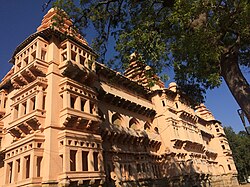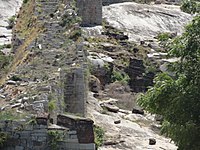| Chandragiri Fort, Tirupati | |
|---|---|
| Tirupati | |
 Raja Mahal of Chandragiri Fort Raja Mahal of Chandragiri Fort | |
  | |
| Coordinates | 13°34′57″N 79°18′20″E / 13.58250°N 79.30556°E / 13.58250; 79.30556 |
| Type | Fort |
| Site information | |
| Controlled by | Government of Andhra Pradesh |
| Condition | Ruins |
| Site history | |
| Built | 11th century |
| Materials | Granite Stones and lime mortar |


Chandragiri Fort is an historical fort located in the Chandragiri suburb of Tirupati. It is situated in Tirupati district of Andhra Pradesh, India. It is mostly associated with the Yadava rulers of Vijayanagara Empire. It was built by Immadi Narasimha Yadavaraya in 1000 CE.
History
Chandragiri was under the rule Vijayanagara empire for about three centuries and came under the control of the Vijayanagara emperors in 1367. It came into prominence during 1560s during the reign of Saluva Narasimha Deva Raya. Later, the most famous Vijayanagara emperor Krishnadevaraya, was kept in this fort as a prince, till his coronation at Penukonda. It is also said that he met his future queen Chinna Devi at this fort. Chandragiri was the 4th capital of Vijayanagara Empire, Rayas shifted their capital to here when the Golconda sultans attacked Penukonda. In 1646 the fort was annexed to the Golkonda territory and subsequently came under Kingdom of Mysore rule. It went into oblivion from 1792 onward. The Raja Mahal Palace is now an archaeological museum. The palace is an example of Vijayanagara architecture of the period. The crowning towers have elements of Dravidian Temple architecture. The palace was constructed using stone, brick, lime mortar and devoid of timber. Some important epic poems are written in this fort under the patronage of Vijayanagara kings. Inside the fort are eight temples, Raja Mahal, Rani Mahal and other ruined structures. Inside the fort are Raja Mahal and Rani Mahal which are quite well maintained for more than 300 years and Raja Mahal is converted as Archeological Museum by Archeological Survey of India. The museum holds models of fort, main temple and other structures of surrounding area. Both of these building were constructed without using wood and only lime, brick and mortar was used. Rani Mahal has flat roof and at base level it has stable and epigraphical evidence says that this building was also used as commanders quarters.
The fort is the place where the pact of granting lands for Fort St. George to the British was signed by Vijayanagara King Sriranga Raya during August 1639.
Vyasathirtha
Sage Vyasatirtha used to reside here and was a spiritual advisor to King Saluva Narasimha Deva Raya and he was entrusted with worship at Tirumala temple. Vyasathirtha remained in Chandragiri in the court of Narasimha Raya II. The fort is at a distance of 11 km from the famous Tirupati Temple and there is a foot path to temple from this fort, which is the reason the sage resided here.
Srivari Mettu
The famous Srivari Mettu, one of the well known walking pathis to Tirumala Venkateswara Temple starts from this fort and it was originally used by Royal family of Vijayanagara Kingdom, which over the years is allowed to be used to public.
References
- ^ Moulana, Ramanujar (16 April 2018). "Day-trip down history lane". Metro Plus. Chennai: The Hindu. p. 4.
- ^ "Raja and Rani Mahal, Chandragiri Fort". Archaeological Survey of India. 2008. Archived from the original on 10 April 2009. Retrieved 30 September 2008.
- ^ Shankar, Anuradha (1 January 2019). "CHANDRAGIRI FORT". Times of India India times. Times of India. Retrieved 5 December 2019.
- "Chandragiri fort". templesof india. 2000. Retrieved 5 December 2019.
| Tirupati | |||||||
|---|---|---|---|---|---|---|---|
| Hindu Temples | |||||||
| Neighbourhoods | |||||||
| Government | |||||||
| Buildings and Monuments |
| ||||||
| Tourist attractions |
| ||||||
| Economy | |||||||
| Higher education |
| ||||||
| Healthcare | |||||||
| Transport |
| ||||||
| Cuisine | |||||||
| Festivals | |||||||
| Geography | |||||||
| Flora and Fauna | |||||||
| River | |||||||
| National parks | |||||||
| Media | |||||||
| Other topics |
| ||||||
| Other topics | |||||||
| Forts in Andhra Pradesh | |
|---|---|
- Tirupati
- Tirupati district
- Forts in Andhra Pradesh
- Buildings and structures in Tirupati
- Vijayanagara Empire
- Archaeological sites in Andhra Pradesh
- 11th-century establishments in India
- Buildings and structures completed in the 11th century
- Monuments of National Importance in Andhra Pradesh
- Palaces in Andhra Pradesh


